Dear Reader, in this age of AI created content, please support with your goodwill someone who works harder to provide the human-made. Sign up at the top of the lefthand column or bottom of this page. You will receive my hand illustrated monthly newsletter RESTORE NATURE and access to the biodiversity garden design course as I write...and nothing else, I respect your time. I am also removing the advertizing as best I can as its become intrusive inappropriate and pays me nothing.
Growing oyster mushrooms on logs
Growing oyster mushrooms on logs requires only a simple recipe, but the ingredients must be just right. This album is based on what we learned at a Guerilla House workshop called "Low Tech Shrooms" which I highly recommend. The workshop untangled some of my misunderstandings about growing mushrooms, set me off on a steep learning curve and also has changed my whole approach to gardening and soil creation.
Oyster mushrooms are primary saprophytes, that means their food is dead plant material that has not been decomposed by other micro organisms. They like straw and wood products like logs, and chip, so you can find suitable unspoiled logs and buy spawn or grow it at home. In this case commercially grown dowel spawn was used. You can see a bag of it in the album on spawn. If you are growing another primary saprophyte (Guerilla House provides lists of mushrooms and their favourite media to workshop attendees) choose a wood that it 'likes'.
 drill holes in a log
drill holes in a log so far apart
so far apart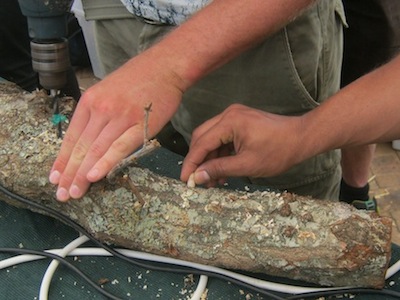 plug the holes
plug the holes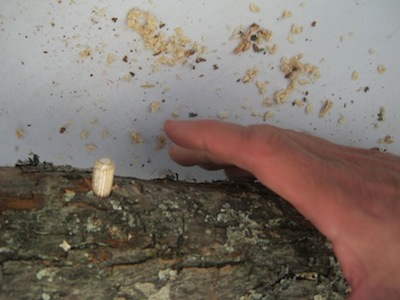 with dowel spawn
with dowel spawn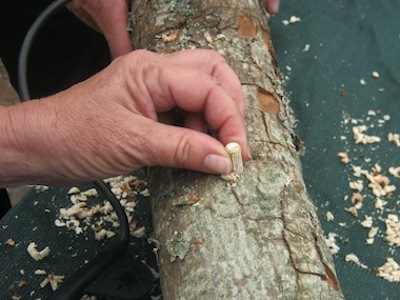
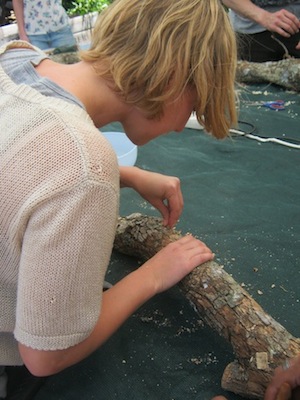 insert plugs
insert plugs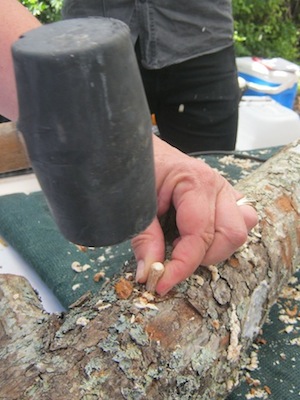 and
and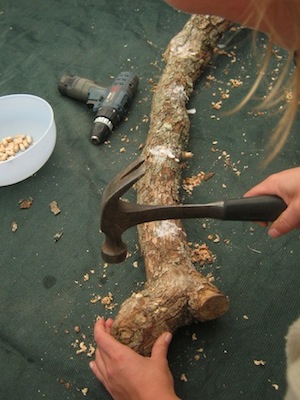 hammer home
hammer home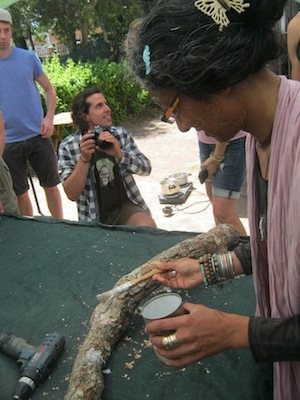 protect the drill area from infection with a thin wax layer
protect the drill area from infection with a thin wax layer
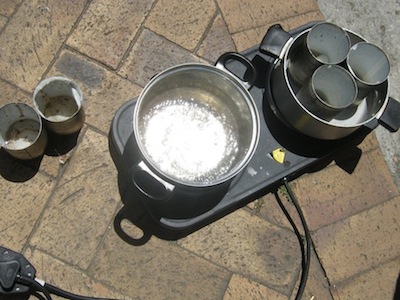 by melting candle wax by melting candle wax |
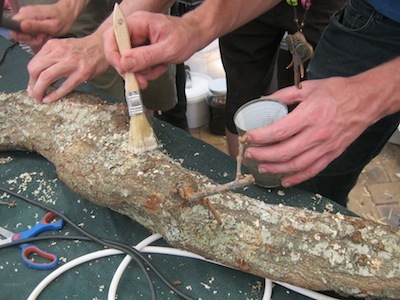 painting it over painting it over |
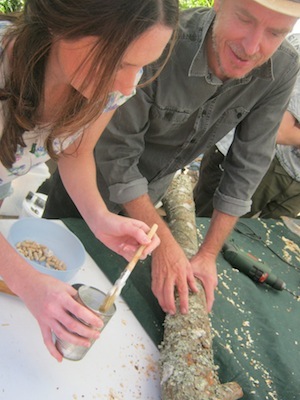
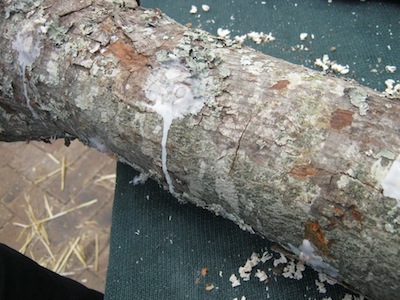 each and every plug
each and every plugSet off on a journey of discovery that is thrilling, rewarding and full of show stopping moments as you stalk the fungus in lonely woods and forest trails........

 but be warned there is a lot to learn but be warned there is a lot to learn |
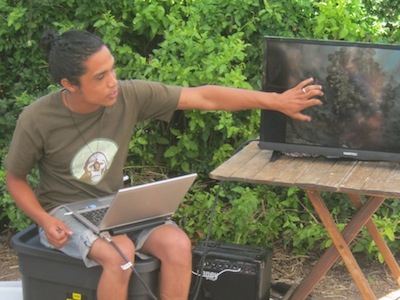 mycology opens up a new universe mycology opens up a new universe |
and its definitely expanding......
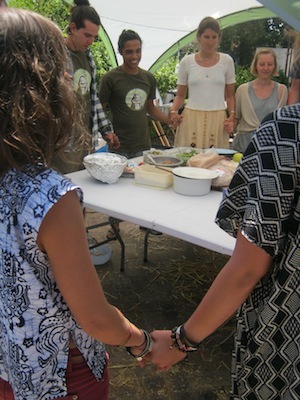 and we give thanks for this and the delicious spin offs
like the oyster mushroom stir fry we are just about to receive !
and we give thanks for this and the delicious spin offs
like the oyster mushroom stir fry we are just about to receive !but
Growing oyster mushrooms is not like falling off a log !
Growing oyster mushrooms is simple, but not as easy as growing some other foods. We need teaching, reading and exchange to make it happen.... and most of all we need practice, and to make mistakes. In honour of this principle I've included mine, post workshop. We went home with a little parcel wrapped in pasteurized cardboard, an oyster mushroom. Here is a list of my little faux pas, I hope they are instructive !
1) I took the parcel home in an old plastic shopping bag, which was highly likely far from sterile.
2) Instead of waiting till the oyster mushroom had thoroughly colonized the cardboard parcel, I whipped on my gloves, tore up the cardboard, which already had a few white threads of mycelium the next day, and placed pieces of torn cardboard in boiled rice.
3) I did not seal the jars with micropore until several days later
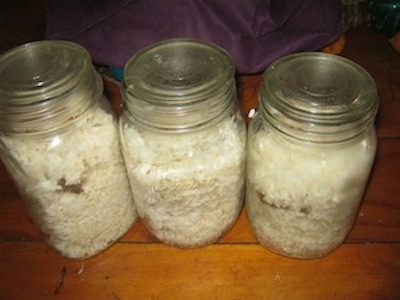
Soon the jars were showing a gray green growth in addition to the snowy white mycelium of the oyster mushroom. Once the jars were filled with mycelium, I put on gloves again and opened them up. I spread them on a pasteurized plastic sheet, cut out all the gray-green growth I could see, mixed them with fermented straw and put them in a pasteurized bag.
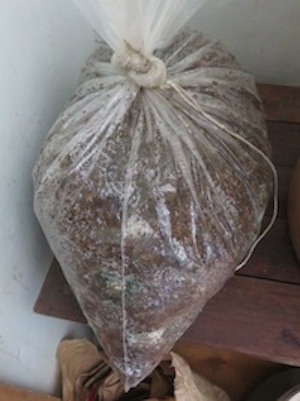
4) The straw was not fully fermented yet
5) There seem not to have been enough puncture holes in the bag.
6) It was impossible to remove the gray-green mold completely from the rice medium
Within days we were back to the situation where the gray green mold was thriving. Though the oyster mycelium is also expanding at this stage, we will see what happens when the waves of expanding mycelium meet. There is dew, a lot of it, on the inside of the bag, which is supposed to be bad, as it can promote rotting.
After the workshop I began reading the downloads Guerilla House sent, such as Paul Stamets book Mycelium Running. When I have money I am going to buy everything he has written. I look back and realize I've made a huge leap forward, because even last week I was getting everything wrong. I've spent decades growing things and it takes time to acquire this combination of new information and experience that build the skill. I am not dismayed by my failures, I'm so glad I went to the workshop and I look forward to new horizons and ways of growing.
------
home page with links to useful articles on natural gardening
------
Vegetable growing and information on easy vegetables
------
Introduction to growing mushrooms
------
growing mushroom spawn with simple technology
------
Restore Nature Newsletter
I've been writing for four years now and I would love to hear from you
Please let me know if you have any questions, comments or stories to share on gardening, permaculture, regenerative agriculture, food forests, natural gardening, do nothing gardening, observations about pests and diseases, foraging, dealing with and using weeds constructively, composting and going offgrid.
SEARCH
Order the Kindle E-book for the SPECIAL PRICE of only
Prices valid till 30.09.2023
Recent Articles
-
garden for life is a blog about saving the earth one garden at a time
Apr 18, 25 01:18 PM
The garden for life blog has short articles on gardening for biodiversity with native plants and regenerating soil for climate amelioration and nutritious food -
Cape Flats Sand Fynbos, Cape Town's most endangered native vegetation!
Apr 18, 25 10:36 AM
Cape Flats Sand Fynbos, a vegetation type found in the super diverse Cape Fynbos region is threatened by Cape Town's urban development and invasive alien plants -
Geography Research Task
Jan 31, 25 11:37 PM
To whom it may concern My name is Tanyaradzwa Madziwa and I am a matric student at Springfield Convent School. As part of our geography syllabus for this
"How to start a profitable worm business on a shoestring budget
Order a printed copy from "Amazon" at the SPECIAL PRICE of only
or a digital version from the "Kindle" store at the SPECIAL PRICE of only
Prices valid till 30.09.2023







